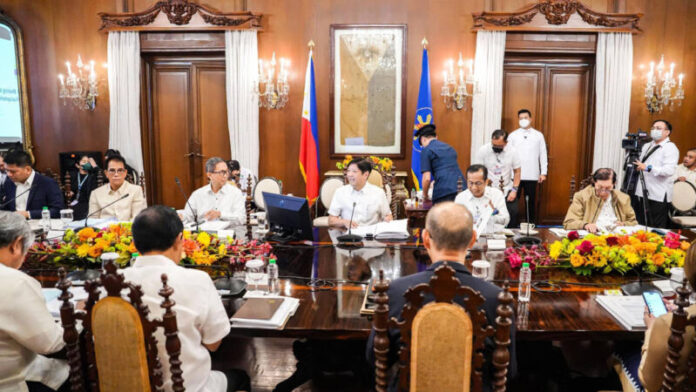• The National Economic and Development Authority Board approved an executive order implementing the Regional Comprehensive Economic Partnership (RCEP)
• President Ferdinand Marcos, Jr. will sign “anytime now” the EO that sets its effectivity on June 2
• The Bureau of Customs will also issue an implementing order and a list of the trade items with preferential tariffs under the RCEP
• Trade Secretary Alfredo Pascual says the EO will maintain current preferential tariffs on about 98.1% of the 1,718 agricultural tariff lines and 82.7% of the 8,102 industrial tariff lines
The National Economic and Development Authority Board, chaired by President Ferdinand Marcos Jr., approved on April 20 an executive order implementing the Regional Comprehensive Economic Partnership (RCEP).
The EO puts into effect the Philippines’ tariff commitments under the mega free trade agreement and directs government agencies to conduct a nationwide educational campaign on how the country can take full advantage of the pact.
Marcos instructed agencies to make RCEP’s benefits “very clear” to the country’s agriculture sector and how they would affect agriculture businesses and operations, Malacañang said in a statement.
“So let’s make it very clear. Ito ‘yung mga puwede nating gawin na hindi natin kayang gawin noon (These are the things we can do that we could not do before). But, basically… we now have access to a two billion population market,” Marcos said, adding the Philippines should strengthen its manufacturing and production to make it more competitive regionally.
At the same time, he said, the trade pact could create new assets for the country and access to supply lines it currently does not have.
RCEP is a free trade agreement (FTA) among the 10 member-states of the Association of Southeast Asian Nations (ASEAN) and its five FTA partners, namely Australia, China, Japan, New Zealand and South Korea.
The agreement was signed on November 15, 2020 after years of negotiations that began in 2012.
In a separate press briefing on April 20, Trade Secretary Alfredo Pascual said the EO implementing RCEP will be signed by Marcos “anytime now, but the effectivity will be in the second of June 2023, so anytime between now and the second of June”.
Pascual said hopefully the order will be signed earlier so the Bureau of Customs (BOC) can prepare its administrative order bearing a list of trade items with preferential tariffs under the RCEP.
The RCEP takes effect on June 2 in the Philippines, 60 days after the instrument of ratification was deposited to the ASEAN secretary general on April 3.
The Philippine Senate ratified RCEP on February 21 via Senate Resolution No. 485.
Pascual described RCEP as a “modern, comprehensive, high-quality and mutually beneficial economic partnership agreement which provides opportunities for market access on trade, services and investments.”
“The agreement also establishes clear, stable and predictable rules on trade and investments in our region, which makes it more convenient and competitive for Philippine businesses and stores to be integrated into the global economy,” he said.
Once issued, Pascual said, the EO implementing RCEP will be the basis of BOC for issuing a customs administrative order that will be distributed to all ports to allow the implementation of preferential tariffs on e-ports from RCEP member countries.
Pascual said that, essentially, the EO will maintain current preferential tariffs on about 98.1% of the 1,718 agricultural tariff lines and 82.7% of the 8,102 industrial tariff lines.
Out of the 1,685 agricultural tariff lines, retained at current rates 1,426 tariff lines are maintained at zero while 154 tariff lines will remain in their respective most favored nation (MFN) rates and excluded from any tariff concession.
Meanwhile, agricultural tariffs on 105 lines, which are on the sensitive and highly sensitive list, will generally be lower than MFN rates in the 20th year of RCEP, but still higher or at par with the ASEAN+1 rates. In other words, the tariffs will not be below the ASEAN+1 rates to which the Philippines is already committed.
For the remaining 33 lines, the EO will reduce tariff rates upon entry into force or implement gradual reduction over a period of 15 to 20 years.
These tariff lines, Pascual said, will involve agricultural products which are not really much produced in the Philippines.
After issuance of the EO implementing RCEP, Pascual said the Department of Trade and Industry (DTI), in conjunction with other government departments, “will have to make the public, particularly the businesses in our country, aware of the benefits that they can gain from RCEP as well as the other existing preferential trade agreements.”
He said DTI will start with the major event on June 9, the launch of the Philippine Export Development Plan 2023-2028 during an international trade forum discussing the benefits that businesses and the country as a whole can gain from RCEP and other preferential trade agreements.
“And, of course, that’s tied up also with the investments that we are trying to bring in, particularly the export-oriented investments,” Pascual added.
A “more detailed educational campaign” will be conducted with industry organizations and sectoral groups to explain the benefits that each of these industries can gain.
Assistance centers for businesses will likewise be established to provide further help on RCEP provisions that will affect industries, Pascual said.
The RCEP covers a market of 2.2 billion people with a combined size of US$26.2 trillion or 30% of the world’s gross domestic product.
The deal will improve market access with tariffs and quotas eliminated in more than 65% of goods traded, and will make business predictable with common rules of origin and transparent regulations. This aims to encourage firms to invest more in the region, including building supply chains and services, and to generate jobs.





